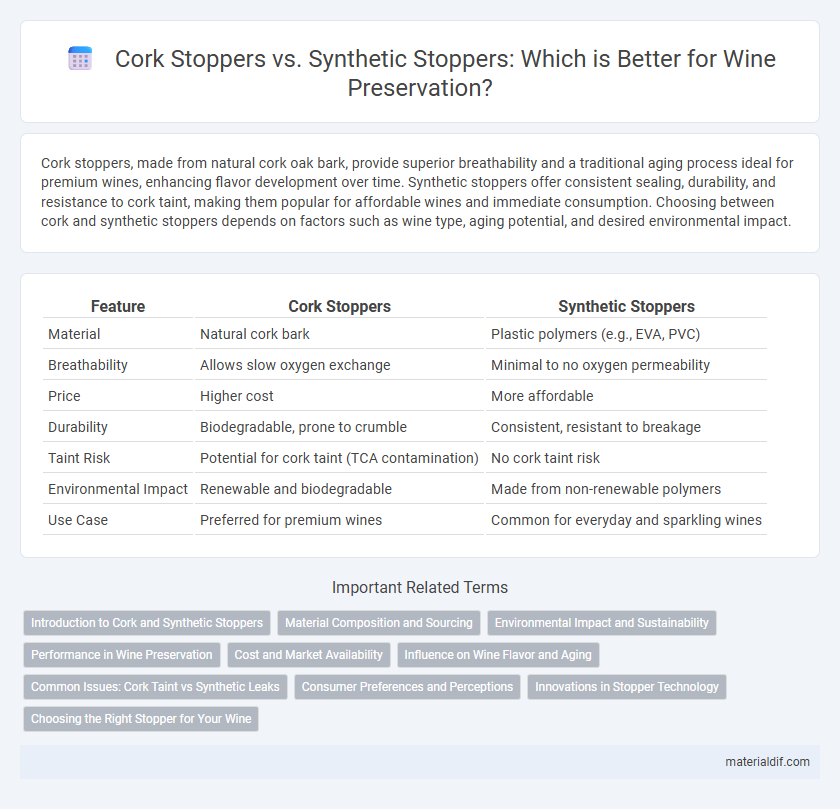Cork stoppers, made from natural cork oak bark, provide superior breathability and a traditional aging process ideal for premium wines, enhancing flavor development over time. Synthetic stoppers offer consistent sealing, durability, and resistance to cork taint, making them popular for affordable wines and immediate consumption. Choosing between cork and synthetic stoppers depends on factors such as wine type, aging potential, and desired environmental impact.
Table of Comparison
| Feature | Cork Stoppers | Synthetic Stoppers |
|---|---|---|
| Material | Natural cork bark | Plastic polymers (e.g., EVA, PVC) |
| Breathability | Allows slow oxygen exchange | Minimal to no oxygen permeability |
| Price | Higher cost | More affordable |
| Durability | Biodegradable, prone to crumble | Consistent, resistant to breakage |
| Taint Risk | Potential for cork taint (TCA contamination) | No cork taint risk |
| Environmental Impact | Renewable and biodegradable | Made from non-renewable polymers |
| Use Case | Preferred for premium wines | Common for everyday and sparkling wines |
Introduction to Cork and Synthetic Stoppers
Cork stoppers are natural closures harvested from the bark of cork oak trees, prized for their elasticity and breathability, which help preserve wine by allowing minimal oxygen exchange. Synthetic stoppers, made from plastic or other synthetic materials, offer consistent sealing properties and eliminate the risk of cork taint. Both types play crucial roles in the wine industry, balancing tradition with technological innovation to maintain wine quality.
Material Composition and Sourcing
Cork stoppers are made from the bark of the Cork Oak tree (Quercus suber), primarily sourced from the Mediterranean regions, especially Portugal and Spain, where sustainable harvesting ensures the bark regenerates without harming the tree. Synthetic stoppers are produced from food-grade plastics such as polyethylene or elastomers, manufactured through chemical processes using petroleum-based raw materials, offering consistent quality but lacking renewable sourcing. The natural cellular structure of cork provides elasticity and breathability, while synthetic alternatives focus on uniformity and resistance to taint but often involve less environmentally friendly sourcing methods.
Environmental Impact and Sustainability
Cork stoppers are highly sustainable due to their renewable nature, as cork oak trees regenerate their bark without being cut down, supporting biodiversity and carbon sequestration. Synthetic stoppers, often made from plastic or foam, pose environmental challenges including non-biodegradability and higher carbon footprints linked to petroleum-based production. The use of natural cork significantly reduces landfill waste and promotes a circular economy in the wine industry, making it an environmentally preferable choice in Cork, Ireland.
Performance in Wine Preservation
Natural cork stoppers excel in oxygen regulation, allowing micro-oxygenation that enhances wine aging and flavor complexity. Synthetic stoppers provide consistent sealing without risk of cork taint but may lack the nuanced breathability needed for long-term preservation. Studies show natural corks maintain wine quality over extended periods, while synthetics are preferred for early consumption wines due to their reliable, inert barrier.
Cost and Market Availability
Cork stoppers generally command higher prices due to their natural sourcing and traditional harvesting methods, with costs typically ranging from $0.10 to $0.30 per unit depending on quality. Synthetic stoppers, made from plastic or rubber compounds, are more cost-effective, often priced between $0.05 and $0.15 each, benefiting from mass production and consistent supply chains. Market availability favors synthetic stoppers in large-scale commercial wineries due to their uniformity and lower cost, while cork stoppers remain preferred in premium wine markets for their natural properties and consumer perception.
Influence on Wine Flavor and Aging
Natural cork stoppers allow micro-oxygenation, which subtly enhances wine flavor complexity and supports optimal aging by preventing premature oxidation. Synthetic stoppers, made from inert materials like plastic or silicone, typically lack this permeability, potentially leading to reduced flavor development and faster aging profiles. Studies show that wines sealed with natural cork exhibit more nuanced aroma evolution and better long-term aging potential compared to synthetic alternatives.
Common Issues: Cork Taint vs Synthetic Leaks
Cork stoppers often face cork taint caused by TCA (2,4,6-trichloroanisole), which leads to musty odors and negatively impacts wine quality. Synthetic stoppers, while free from TCA contamination, can suffer from synthetic leaks due to inconsistent material density, potentially resulting in premature oxidation. Both types pose risks to wine preservation, making the choice between natural cork and synthetic closures crucial for maintaining optimal wine integrity.
Consumer Preferences and Perceptions
Consumers in Cork often prefer cork stoppers for their natural origin and traditional association with quality wine preservation, perceiving them as eco-friendly and capable of allowing beneficial micro-oxygenation. Synthetic stoppers, however, appeal to consumers prioritizing consistency, affordability, and resistance to cork taint, leading to growing acceptance in the local market. Surveys indicate that wine enthusiasts in Cork value authenticity from cork stoppers, while casual drinkers favor the reliability and cost-effectiveness of synthetic alternatives.
Innovations in Stopper Technology
Innovations in stopper technology have significantly advanced both cork and synthetic stoppers, enhancing performance and sustainability in the wine industry. Natural cork stoppers now feature improved quality control measures and surface treatments to reduce TCA contamination while maintaining their unique breathability. Synthetic stoppers have evolved with bio-based polymers and precise oxygen transmission rates, offering consistent sealing and a cost-effective alternative for premium wine preservation.
Choosing the Right Stopper for Your Wine
Cork stoppers provide natural aging benefits and allow micro-oxygenation, enhancing the wine's complexity over time, making them ideal for premium wines intended for long-term storage. Synthetic stoppers offer consistent sealing and are free from cork taint, ensuring reliable preservation for wines consumed within a few years. Selecting the right stopper depends on the wine style, aging expectations, and storage conditions, balancing tradition and practicality in cork versus synthetic options.
Cork Stoppers vs Synthetic Stoppers Infographic

 materialdif.com
materialdif.com